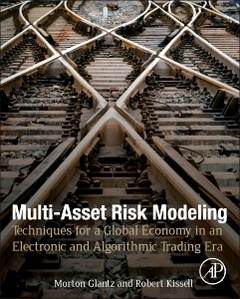Description
Multi-Asset Risk Modeling
Techniques for a Global Economy in an Electronic and Algorithmic Trading Era
Authors: Glantz Morton, Kissell Robert
Language: English
Subjects for Multi-Asset Risk Modeling:
544 p. · 19x23.3 cm · Hardback
Description
/li>Contents
/li>Readership
/li>Biography
/li>Comment
/li>
- Introduction to Multi-Asset Risk Modeling – Lessons from the Debt Crisis
- A Primer on Risk Mathematics
- A Primer on Quantitative Risk Analysis - by Johnathan Mun
- Price Volatility
- Factor Models
- Equity Derivatives
- Foreign Exchange Market and Interest Rates
- Algorithmic Trading Risk
- Risk Hedging Techniques
- Rating Credit Risk: Current Practices, Model Design and Applications
- A Basic Credit Default Swap Model
- Multi-Asset Corporate Restructurings and Valuations
- Extreme Value Theory and Application to Market Shocks for Stress Testing and Extreme Value at Risk
- Case Study: Ensuring Sustainability of an Institution as a Going Concern: An Approach to Dealing with Black Swan or Tail Risk - by Karamjeet Paul
Undergraduate and graduate students, professors, and professionals working with financial risk management techniques who want reference information about theoretical models and applications.
As a JP Morgan Chase (heritage bank) senior banker, Professor Glantz built a progressive career path specializing in credit analysis and credit risk management, risk grading systems, valuation models, and professional training. He was instrumental in the reorganization and development of the credit analysis module of the Bank’s Management Training Program-Finance, which at the time was recognized as one of the foremost training programs in the banking industry.
Professor Glantz is on the (adjunct) finance faculty of the Fordham Graduate School of Business. He has appeared in the Harvard University International Directory of Business and Management Scholars and Research, and has earned Fordham University Deans Award for Faculty Excellence on three occasions. He is a Board Member of the International Standards Board, International Institute of Professional Education and Research (IIPER). The IIPER is a global institute with partners and offices around the world, including the United States, Switzerland, Hong Kong, Mexico, Portugal, Singapore, Nigeria, and Malaysia. Professor Glantz is widely published in financial journals and has authored 8 books.
Robert Kissell, Ph.D., is President of Kissell Research Group, a global financial and economic consulting firm specializing
- Covers all asset classes
- Provides mathematical theoretical explanations of risk as well as practical examples with empirical data
- Includes sections on equity risk modeling, futures and derivatives, credit markets, foreign exchange, and commodities




